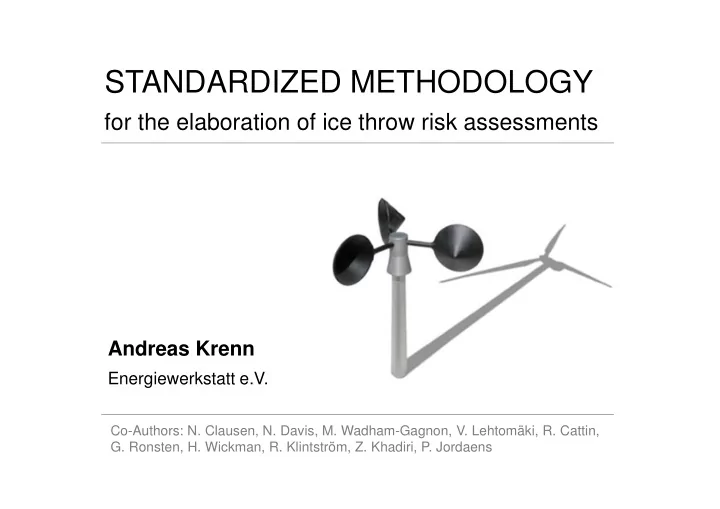

STANDARDIZED METHODOLOGY for the elaboration of ice throw risk assessments Andreas Krenn Energiewerkstatt e.V. Co-Authors: N. Clausen, N. Davis, M. Wadham-Gagnon, V. Lehtomäki, R. Cattin, G. Ronsten, H. Wickman, R. Klintström, Z. Khadiri, P. Jordaens
Standardized Methodology for the elaboration of Ice-Throw-Risk-Assessments Empiric formula vs. risk assessments Ice throw results provided by Meteotest, CH Fig.: Case example – ice fall Fig.: Case example – ice throw Winterwind 2016, Åre
Standardized Methodology for the elaboration of Ice-Throw-Risk-Assessments Assumptions and uncertainties • Ballistic model – Aerodynamic parameters (rotation, drag & lift, flight trajectories…) – Consideration of different ice fragments • Data basis for the specific location – Icing intensity (number of icing events, amount of relevant ice fragments, weight distribution…) – Wind speed and wind direction distribution • Risk Assessment – Probability of persons in the danger zone – What is the acceptable risk level for persons, for cars … – Assessment of mitigation measures Winterwind 2016, Åre
Standardized Methodology for the elaboration of Ice-Throw-Risk-Assessments Sensitivity Analysis Case Example – Ice Fall – Average Location in Lower Austria – Blade tip height of WT: 200 m – Wind data based on neighbouring wind met mast (50m, 1 year) – Icing intensity: Fig.: Wind direction • 5 icing events/year (evaluation of wind measurement data) • Intensity estimated by experience: Light/moderate icing � 500 fragments / year (conservative) – Superposition of 4 different fragments Fig.: Weight distribution Winterwind 2016, Åre
Standardized Methodology for the elaboration of Ice-Throw-Risk-Assessments Different weight distributions Dimensions Mass Numbers Dimensions Mass Numbers 3x4x8cm 3x5x10cm 50 % 86g 250 77 % 90g 385 35 % 5x8x10cm 240g 175 14 % 3x9x10cm 243g 69 5x10x50cm 10x13x20cm 10 % 1,5kg 50 9 % 1,6kg 44 5 % 3x20x100cm 5,4kg 25 0,4 % 16x19x20cm 5,5kg 2 Fig.: Scenario A; Fig.: Scenario B; Dmax = 154m Dmax = 190m Winterwind 2016, Åre
Standardized Methodology for the elaboration of Ice-Throw-Risk-Assessments Distribution of ice accretion on the blade Fig.: Break-off of ice-fragments Fig.: Break-off of ice-fragments from the entire rotor radius from the outer third of the rotor Winterwind 2016, Åre
Standardized Methodology for the elaboration of Ice-Throw-Risk-Assessments Influence of roughness length Anemometer height=50m Anemometer height=50m RZ=0,2 RZ=0 – Maximum distance: 154m vs. 126m – Average hits/sqm: 9,7 ∗ 10 �� vs. 1,3 ∗ 10 �� Winterwind 2016, Åre
Standardized Methodology for the elaboration of Ice-Throw-Risk-Assessments Wind speed data 10 Minutes averages, 1-h Reanalysis Data 3 sec. Maximum readings Measuring height = 50m Measuring height = 50m Measuring height = 50m Wind Data Max. Wind speed [m] Max Range [m] Average hits per sqm 9,7 ∗ 10 �� 10 Minutes averages 154 21 8,4 ∗ 10 �� 3 Seconds maximum readings 180 27 1,6 ∗ 10 �� 1 Hour reanalysis Dara 118 17 Winterwind 2016, Åre
Standardized Methodology for the elaboration of Ice-Throw-Risk-Assessments Assumptions for risk assessment • Commonly accepted risk level – Individual risk vs. collective risk – ALARP vs. MEM (levels range from 10 -5 to 10 -7 ) • Thresholds for lethal injuries – Kinetic energy vs. weight – Hits per m 2 vs. hits per size of head • Mitigation measures (warning signs, flashing lights…) – Efficiency / effectiveness of the individual measures – Reduction ration: One order of magnitude? Winterwind 2016, Åre
Standardized Methodology for the elaboration of Ice-Throw-Risk-Assessments Where do we stand? Guideline Lack of Data Public Consultant Authorities Winterwind 2016, Åre
Standardized Methodology for the elaboration of Ice-Throw-Risk-Assessments Project objectives • Main Targets – International guidelines/recommendations for the elaboration of ice-throw / ice-fall risk assessments • Paving the way to more transparency • Awareness of consultants and authorities about crucial parameters • Working procedure – Cooperation within Task 19 plus interested external experts – Comparing different approaches and results – Detailed setup (meetings, case examples…) dependent on number and origin of partner companies • Positive side effect for participants – Learning effect and further improvement of their models Winterwind 2016, Åre
STANDARDIZED METHODOLOGY for the elaboration of ice throw risk assessments Photo: The Alps Source: Energiewerkstatt Thanks for your Attention.
Recommend
More recommend